15.5 Managing User Disk Space Usage with User Data Quotas
As time passes, your Novell Teaming site occupies more and more disk space as users create workspaces and folders, post folder entries, attach files, create new versions of files, and so on. As the Teaming administrator, you can impose limits on the amount of data that users are permitted to upload into the Teaming site. Each user’s data quota establishes how much disk space the user’s attached files and file versions can occupy in the Teaming site. Workspaces, folders, and entries that do not contain files or attachments do not count toward a user’s data quota.
By default, users are not limited in the disk space that their attached files and file versions occupy in the Teaming site. As the Teaming administrator, you can decide when limiting users’ disk space usage becomes appropriate.
15.5.1 Planning User Data Quotas
Understanding Default Data Quota Behavior
The following sections describe the default behavior for how user data quotas work after they have been enabled. For information on how to enable data quotas for your Teaming site, see Section 15.5.2, Setting Data Quotas.
Exceeding the Data Quota
By default, Teaming users are strictly held to the data quota that you set. If a user who is approaching his or her data quota tries to upload a file to the Teaming site and that file exceeds the user’s data quota, Teaming rejects the upload attempt and the entry is lost.
As a Teaming administrator, you might want to allow users to post a final entry to the Teaming site that exceeds their data quota. This approach is less strict and does not guarantee that users won’t exceed their data quotas; however, it is more forgiving because it allows users to post one final upload to the Teaming site and does not erase the entry and attached file that they are trying to upload.
For information on how to configure your Teaming data quotas to be less strict by allowing users one final upload to the Teaming site, and thus exceed their data quota, see Section 15.5.6, Configuring Data Quotas to Be Less Strict.
Exceeding the High-Water Mark
When users exceed their data quota high-water mark, they are notified that they are approaching their data quota. Teaming informs them how many kilobytes of disk space they still have available.
For more information on selecting an appropriate high-water mark, see Selecting an Appropriate High-Water Mark.
Understanding Data Quota Priority
Because users can have multiple data quotas assigned to them, either individually, through group membership, or through the site-wide default, Teaming prioritizes the existing data quotas and uses only one for each individual Teaming user. If users have multiple data quotas that pertain to them, the priority level is as follows:
-
User Quota: A quota that is set for an individual user overrides the site-wide default quota and any other quotas that are associated with any groups where the user is a member.
-
Group Quota: A quota that is set for an individual group overrides the site-wide default quota. This pertains to all users who are a member of that group.
When a user is a member of multiple groups that have a data quota associated with them, the user is given the highest data quota. For example, if a Teaming user is a member of Group A, Group B, and Group C, and the data quotas for each of these groups is 10, 20, and 30, respectively, the Teaming user’s data quota is 30.
-
Site-Wide Default: The site-wide default quota is used for all Teaming users who have not been assigned individual quotas, and who are not associated with any groups where a quota has been set.
Understanding Data Quota Exclusions
Mirrored Folders
Files stored in mirrored folders do not count against a user’s data quota because they are not uploaded into the Teaming site.
Selecting the Default User Data Quota for All Users
When you enable the data quota feature, the initial default data quota is 100 MB. This means that each Teaming user can upload 100 MB of files and attachments to the Teaming site. There is one default data quota for each Teaming zone. When a user adds enough files and attachments to exceed the data quota, the user can no longer attach files or create versions until existing files have been deleted and purged to free up storage space. Users can add a file that exceeds their data quota if they have not already exceeded their data quota. Users cannot add additional files until they are again below their quota. This prevents users from creating an entry and then having the entry rejected. For information about the user experience of nearing or exceeding a data quota, see Adding Files and Attachments to the Teaming Site When You Are Over Your Quota
in the Novell Teaming 2.1 Advanced User Guide.
For information about purging deleted files to make storage space available, see Section 15.5.8, Purging Deleted Files.
When you select the default data quota for your Teaming site, consider the size of your Teaming site, the number of Teaming users, the amount of available disk space, and so on. You can override the default data quota on a per-user and per-group basis, as described in Section 15.5.2, Setting Data Quotas.
For information about which data quota is used when users have multiple data quotas that pertain to them, see Understanding Data Quota Priority.
Selecting an Appropriate High-Water Mark
The high-water mark is the percentage of the data quota at which users are notified that they are approaching their data quotas. The default high-water mark is 90% of a user’s data quota.
Determining Data Quotas for Specific Users
If there is a user in your Teaming site who needs either a higher or lower data quota than the site-wide default, you can assign that user an individual user data quota.
When you set data quotas for specific users, remember that individual user data quotas override the default user data quota, as well quotas that are assigned to any groups where the user is a member, as described in Understanding Data Quota Priority.
Determining Data Quotas for Specific Groups
When you set data quotas for specific groups, remember that group data quotas override the default site-wide data quota, but do not override individual user quotas, as described in Understanding Data Quota Priority.
15.5.2 Setting Data Quotas
You can set data quotas for the entire Teaming site, for individual groups, and for individual users.
Setting a Default Data Quota
When you set a default data quota, the quota applies to all Teaming users who have not been assigned individual quotas, and who are not associated with any groups where a quota has been set.
-
Log in to the Teaming site as the Teaming administrator.
-
On the Workspace toolbar, click .
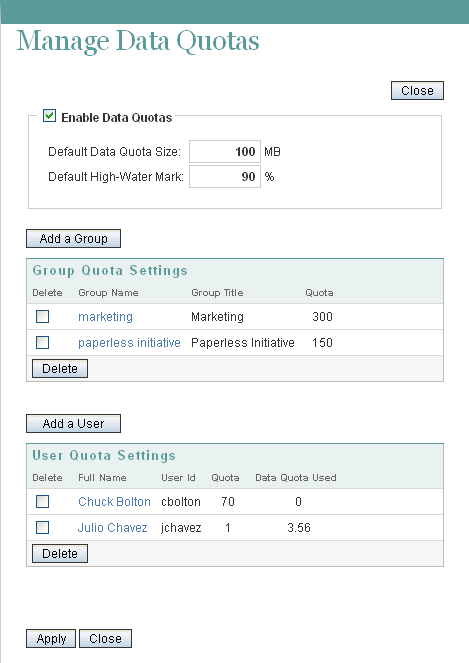
-
Select .
-
Set the and options as determined in Section 15.5.1, Planning User Data Quotas.
-
Click , then click > to save the user data quota settings.
Setting Data Quotas for Individual Groups
-
Log in to the Teaming site as the Teaming administrator.
-
On the Workspace toolbar, click .

-
Select .
-
Click .
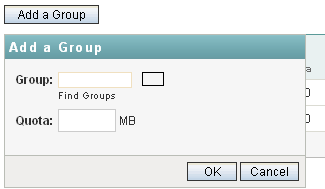
-
In the field, start typing the name of the group for which you want to set a quota, then click the group name when it appears in the drop-down list.
-
(Optional) Repeat Step 5 to add additional groups for which you want to assign the same data quota.
-
In the field, specify the disk space limit for the group.
-
Click , then click > to save the user data quota settings.
Setting Data Quotas for Individual Users
-
Log in to the Teaming site as the Teaming administrator.
-
On the Workspace toolbar, click .

-
Select .
-
Click .
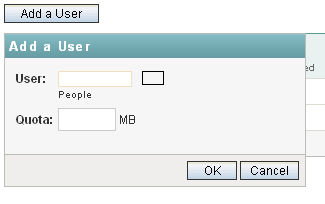
-
In the field, start typing the name of the user for which you want to set a quota, then click the user’s name when it appears in the drop-down list.
-
(Optional) Repeat Step 5 to add additional users for which you want to assign the same data quota.
-
In the field, specify the disk space limit for the user.
-
Click to save the user data quota settings.
15.5.3 Modifying Data Quotas
Teaming enables you to modify data quotas that you have previously set. You can modify data quotas for your entire Teaming site, or modify data quotas for individual groups and users.
Modifying Data Quotas for the Entire Teaming Site
Teaming enables you to easily modify the site-wide default data quota.
-
Log in to the Teaming site as the Teaming administrator.
-
On the Workspace toolbar, click .

-
In the field, delete the existing quota and specify the new quota.
You can also modify the default high-water mark in the field. For more information about the high-water mark, see Selecting an Appropriate High-Water Mark.
-
Click > to save the user data quota settings.
Modifying Data Quotas for Individual Groups and Users
Teaming enables you to easily modify individual group and user data quota settings that you have previously set.
-
Log in to the Teaming site as the Teaming administrator.
-
On the Workspace toolbar, click .

-
In the table or table, click the group name or user name that represents the group or user whose quota you want to modify.
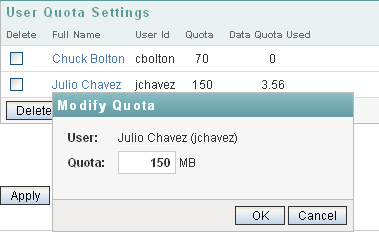
-
In the field, delete the existing quota and specify a new quota.
-
Click , then click > to save the user data quota settings.
15.5.4 Removing Data Quotas
Teaming enables you to disable data quotas that you have previously set. You can disable data quotas for your entire Teaming site, or remove data quotas from individual groups and users.
Disabling Data Quotas for the Entire Teaming Site
If you decide that you no longer need to impose limits on the amount of data that users are permitted to upload into the Teaming site, you can disable the data quota feature. Disabling the data quota feature enables all Teaming users to upload as much data to the Teaming site as they want.
-
Log in to the Teaming site as the Teaming administrator.
-
On the Workspace toolbar, click .
The Manage Data Quotas page is displayed.
-
Deselect , then click .
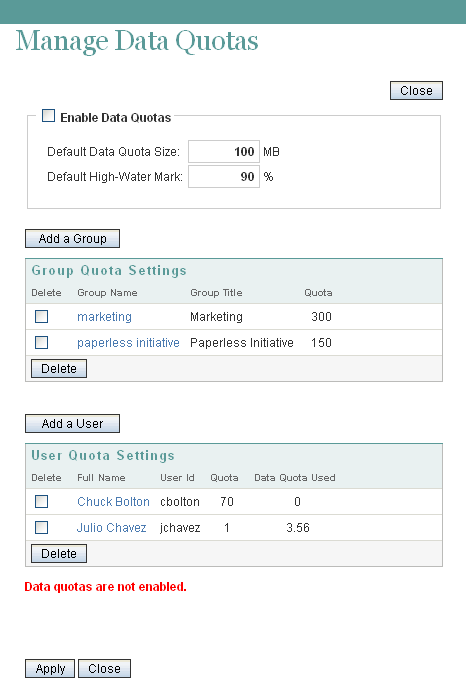
Data quotas are no longer enabled for your Teaming site.
Removing Data Quotas from Individual Groups and Users
You can remove data quotas that you have previously set for individual groups and users. Users are held to the site-wide data quota default setting if they do not have an individual quota defined for them and they are not members of any groups where a group quota has been assigned.
-
Log in to the Teaming site as the Teaming administrator.
-
On the Workspace toolbar, click .

-
In the table or table, select the check box next to the group or user whose quota you want to remove.
-
Click , then click > to save the user data quota settings.
15.5.5 Monitoring User Data Quotas
You can monitor which users in the Teaming site have exceeded or are close to exceeding their data quotas by generating the following reports:
15.5.6 Configuring Data Quotas to Be Less Strict
As a Teaming administrator, you can decide how strictly you want to enforce data quota adherence. You can maintain the default behavior, or you can be less strict by allowing users to post a final entry that exceeds their data quota.
For more information about the default behavior for a data quota, see Understanding Default Data Quota Behavior.
To configure Teaming to allow users to post a final entry that exceeds their data quota:
-
Change to the following directory:
-
Make a backup copy of the ssf-ext.properties file.
-
Open the ssf-ext.properties file in a text editor.
-
Add the following line to the ssf-ext.properties file:
data.quota.strict.conformance=false
-
Save and close the ssf-ext.properties file.
-
Stop and restart Teaming.
15.5.7 Managing Your Personal Data Quota
NOTE:As a Teaming administrator, you are also held to a data quota. If you want to assign yourself a larger quota than the site-wide default, you can add an individual quota for yourself, as described in Setting Data Quotas for Individual Users.
All Teaming users need to manage their personal data quotas. When you have a limited allocation of disk space, you need to be aware of the amount of disk space that you have available, know how to make more disk space available as you approach your quota, and know what counts against your quota and what doesn’t.
For information on how to accomplish these and other important tasks as you manage your data quota, see Managing Your Data Quota
in the Novell Teaming 2.1 Advanced User Guide.
15.5.8 Purging Deleted Files
When users delete files or file versions, the disk space occupied by the deleted files and versions counts against users’ data quotas until users purge their files and versions, as described in Making Disk Space Available by Purging Deleted Items
in the Novell Teaming 2.1 Advanced User Guide.
As a Teaming administrator, you can purge files and versions anywhere on the Teaming site in order to recover disk space.
-
Log in to the Teaming site as the Teaming administrator.
-
Click .
All global workspaces, team workspaces, and personal workspaces are located under the Home Workspace.
-
Click to display a list of all deleted files and versions.
By default, the list is ordered alphabetically by title.
-
(Optional) Click a column heading to sort the list by when items were deleted, who deleted the items, or where the items were deleted on the Teaming site.
-
Select items to purge, then click .
After items have been purged, they cannot be recovered except from the archive store, as described in Section 20.4, Manually Restoring Individual Files.